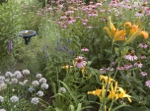How to Attract Pollinators: 6 Must-Have Plants
Habitat loss, disease, and excessive pesticide use are responsible for the drop in pollinator numbers. Planting pollinator-friendly flora can help encourage their return.
Different flower traits attract different garden guests. Butterflies, for example, are partial to purple flowers, while bees are especially attracted to bright white, yellow, or blue. Bats prefer musty smelling flowers that release their scent at night, while pollinating birds show little attraction to fragrance.
North American Pollinator Protection Campaign NAPPC recommends that gardeners choose a variety of plants to provide nectar and pollen throughout the growing season, and suggests leaving some areas of bare ground for nesting bees. Above all, eliminate pesticide use, which kills the pollinators as well as the pests.
1. Common Milkweed (Asclepias syriaca);
2. Butterfly Weed (Asclepias tuberosa);
3. Monarda (Bee Balm);
4. Purple Cone Flower (Echinacea);
5. Solidago (Goldenrod); and
6. Lavender.
Please contact us if you are interested in any of these plants!
Michael. Hanus.Academy@gmail.com AcademyScience.us
http://www.theepochtimes.com/n3/234012-top-six-american-plants-for-pollinators/
Bees are the most important pollinators of our fruits, vegetables, and crops including alfalfa hay that feed our farm animals. Honey bees and thousands of native bee species rely on the flowers they pollinate for good nutrition and health. Bees are being pushed to the tipping point by various factors, such as disruption of natural habitats, diseases and parasites, and widespread overuse of pesticides.
http://www.minnesotafarmguide.com/news/crop/protect-pollinators-while-trying-to-protect-your-crops/article_c76e236e-03aa-11e3-b8ea-0019bb2963f4.html
Improper Agriculture spray use stories similar to this one are becoming common:
Lab tests demonstrate that the deaths are often caused by chemicals similar to dinotefuran, an insecticide applied to control aphids. Dinotefuran is a neonicotinoid, the most widely used group of insecticides and ones that are implicated in bee die-offs the world over.
There is a Legislative solution:
The Saving America’s Pollinators Act (H.R. 2692) suspends certain uses of neonicotinoids, providing a time-out for these insecticides until the EPA can determine if they are safe to use on crops that are visited by bees.
H.R. 2692: Saving America’s Pollinators Act of 2013
http://www.govtrack.us/congress/bills/113/hr2692
You can also take direct action to reduce the threat from neonicotinoids:
Check your own garage or garden shed for neonicotinoid products, and stop using them.
For more information, see the brochure “Protecting Bees from Neonicotinoid Insecticides in Your Garden” and the recent Wings article “Neonicotinoids in Your Garden.” Both are available at www.xerces.org/pesticides
